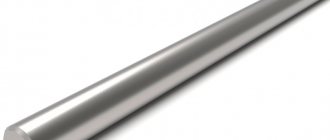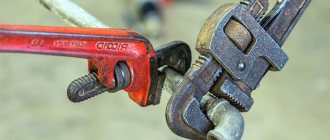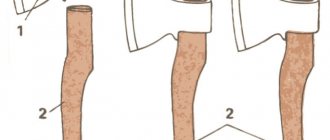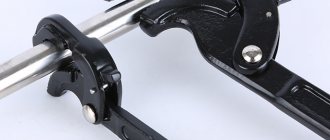Wrenches
Wrench
A wrench is a tool for creating a large torque (a pair of forces) on a nut or screw head. This facilitates either tightening or unscrewing the threaded connection. The first nuts were square, but then the shape of a regular hexagon at the base was taken as a basis. This reduced the angle at which the wrench bar (lever) can be held while working. If for a square nut it was 90 degrees, now it is 60. Wrenches are divided into three main types.
Types of keys and geometry
Open-end wrenches
The most familiar to us and, most likely, the most commonly used type of wrench. The ends of this key resemble “horns,” hence the name. There are two sizes on the ends of these keys, for example, 10 by 12, 13 by 15, and so on. They have a wide range of sizes: from the smallest 4mm to the largest 55mm. You can purchase such keys either individually or in sets of several pieces.
Single-sided open-end wrenches
A rather rare key in the household, it is mainly used in industry. Hence their sizes: the smallest is 36mm, and the largest is 95mm. A very important advantage is the ability to put a metal pipe on the handle, which will increase the leverage and significantly increase the tightening force.
Double-sided spanners
It differs from an open-end wrench in that the ends of these keys are made in the form of rings. This allows the key not to break off and allows for torsion without repositioning the key. The sizes at different ends of the key are different, for example 10 by 12, or 17 by 19. Sizes vary from 6mm to 55mm.
Single-sided spanners
Like single-sided open-end wrenches, single-sided spanners are not very common in households. Its dimensions range from 30 to 50mm. You can increase the tightening force by putting a metal pipe on the handle.
A type of single-sided socket wrench is the impact socket wrench. Outwardly similar to a single-sided spanner, but much thicker and equipped with a special platform for striking with a hammer or sledgehammer. This wrench is used for powerful tightening; its dimensions vary from 27 to 105 mm.
Combination keys
These wrenches are a combination of an open-end wrench and a socket wrench: on one side there is an open-end wrench of a certain size, and on the other hand there is a socket wrench of the same size. The sizes of such keys vary from 5 to 32 mm.
Socket wrenches
Such keys are also called tubular. This type is familiar to any motorist - this is the key used to unscrew and tighten the wheels. The main purpose of such a wrench is to unscrew recessed nuts or bolt heads when no other wrench can be used. They can be made simply in the form of a tube - such a key is rotated using any lever threaded through a special hole at the end, or have an L-shape - it is simply rotated by hand or a pipe (to increase the force).
Adjustable wrenches
This is the most common type of key in the household. Equipped with adjustable jaws, this wrench easily adjusts to the size of the nut. Adjustable wrenches are small - up to 20mm, medium - up to 30mm and large - up to 46mm.
When choosing such a wrench, make sure that the jaws move easily and smoothly when moving apart, and also that there is no play. Buy a wrench with a rubber-coated handle - this will prevent your hand from slipping. Some adjustable wrenches have digital markings on them, allowing you to set the wrench to the required size and even measure the size of the part instead of using a caliper. As a rule, adjustable wrenches have a small allowance, so if the maximum size is specified as 19 mm, then when fully extended, you will almost certainly be able to unscrew a nut with a size of 20 mm.
Pipe wrenches
People sometimes call them gas keys. These keys are universal. They can be used to unscrew both regular nuts and parts that do not have special grips (couplings, pipes, etc.). The key expands to different diameters of the parts to be grasped. Depending on the maximum diameter, keys are divided into the following categories in the Russian classification: No. 1 (from 10 to 36 mm), No. 2 (from 20 to 50 mm), No. 3 (from 20 to 63 mm), No. 4 (from 25 to 90 mm), No. 5 (from 32 to 120mm). In the Western classification, keys are marked by inches: 1, 1.5, 2, 3 inches.
Pipe wrenches also differ in the shape of their jaws. Jaws can be L-shaped - well suited for unscrewing regular nuts and S-shaped for unscrewing round workpieces.
Non-sparking keys
If you come across a yellow or red (copper) key, then this is a non-sparking key. Such keys are used in explosive industries; they do not produce a spark when hitting metal or falling. When working with gas, it is imperative to use just such keys.
Key dimensions and material
Keys in continental Europe are numbered by the distance between parallel edges, expressed in millimeters. In the Russian Empire, and later in the USSR, German technology mainly predominated, and the influence of German engineers was stronger than the influence of the British. Therefore, millimeters took precedence over inches; Soviet GOSTs were based on German standards. Keys can be divided into three groups: small, medium and large.
Small wrenches are designed to work with nuts up to 10-12 mm in size. Medium keys occupy a range from 12 to 22 mm. Large keys - from 22 onwards. This division is quite arbitrary and depends on the equipment being assembled or repaired.
To ensure that mechanics and electricians do not interfere with the work of related specialists, which helps prevent accidents, a rather nice move was made: “mechanical” keys have even numbers, and keys for electrical connections have odd numbers.
The material for wrenches is high-strength carbon alloys, the so-called tool steel. The ideal keys are those that are made from tool steel on milling machines and blued ("black" keys). Military-type firearms are often made from this steel. The main attention should be paid to the edges - the accuracy of their processing is crucial. Only this will allow the greatest torque to be applied to the nut without damaging (“collapsing”) the shape of its edges. Such a key is worth any money, since it is an eternal key, in the literal sense, if you protect it from rusting by lubricating it and storing it in a dry place. Unfortunately, such keys are now rare. Cast and stamped keys that shine like silver may be beautiful, but from a specialist's point of view they are just junk. Do not try to purchase sets - it is expensive and not optimal. Even if the wrenches are good, select the tool strictly individually for your job.
Wrench selection
So, before you pay for wrenches, evaluate them for the job they require. The previous sections should help you with this. For tight nuts, buy only the best wrenches. If the nut is available, choose a wide wrench with strong arms - it will not break. If the geometry of the mechanism is complex, a useful tip is to make a model of the key from plasticine and evaluate it for accessibility of the operation. Be a little bit of both a designer and a technologist. When purchasing, choose a wrench: 1) from the best grades of steel; 2) with the most precise and cleanly processed edges and the most suitable edge height.
Concept and main characteristics
A wrench is a tool designed to connect and disconnect a threaded fastening joint by rotating threaded parts - nuts, bolts, pipes, etc.
To tighten (unscrew) a part, an external force is applied, created by human muscular force and applied to the object. The torque is equal to the product of the radius vector drawn from the axis of rotation to the point of application of the force and the force vector. An increase in torque is achieved by lengthening the length of the tool handle and increasing the maximum applied force, which directly depends on the physical capabilities of the person.
For the best transmission of torque, it is necessary that the working profile of the wrench fits tightly to the surface of the part, but does not damage it during the application of force and does not damage itself. The hardness of the working profile is achieved by making keys from a special material (tool steel with the addition of vanadium and chromium). The hardness of the working profile of the tool is standardized in national and international standardization systems.
Places for keys and heads of fasteners, T-shaped grooves
In technology, a wrench is a specialized tool that is designed to assemble or disassemble threaded connections. To do this, they unscrew bolts or nuts from other parts, or screw them to them.
All wrenches in technology are divided into two main types: male and female. The holes into which nuts or bolt heads are inserted are called sheds, and their sizes are standardized . In the metric system they are measured in millimeters, and in the inch system they are measured in fractions of an inch.
Despite the fact that the design of a wrench is very simple and unpretentious, it finds extremely wide application: almost no assembly production can do without this tool; it is necessary when repairing a wide variety of equipment. There are spanners in space, for example, on the International Space Station.
If we talk about which of the many types of wrenches is more common than others, then open-end wrenches are, of course, the most common. As for the material used for their manufacture, the most common is high-quality tool steel, which contains chromium and vanadium as the main alloying additives.
Main types of classifications
All wrenches can be divided into two main groups: female and male. Tools of the first category with their working profile cover the part from its outer sides. Female wrenches include the most common open-end wrenches, gas wrenches, box wrenches, etc. Male wrenches, on the contrary, are placed in the hole of the part (slot), these include hexagons, star-shaped, Bristol, etc.
Also, all keys are usually divided into the following categories:
- Monolithic
Made from an all-metal structure with a constant working profile size.
- Composite
They consist of a handle and a socket in which interchangeable heads of different sizes are attached.
There are a lot of types of wrenches, but not all of them are widely used in everyday life. A significant part of the varieties of such tools is used in special industries or in a professional environment. Therefore, we will describe only the main varieties of this tool.
Carob
The most common type of wrench. They got their name because their ends actually resemble animal horns. The open-end wrench has an open U-shaped mouth, its working profile covers the part from 2 or 3 sides.
The distance between the jaws at the two ends is different, which allows you to use one tool when working with nuts of different sizes. For better transmission of torque and increased range of use in hard-to-reach places, the axes of the open-end wrench heads are deviated by 15 °C relative to the longitudinal axis of the handle.
Carob one-sided
Single-sided open-end wrenches are quite rare in everyday life - they are usually used in production. To increase the torque, a pipe can be placed on the free end of the tool. Typically, such a tool has a large size between the jaws - from 36 to 65 mm.
Cap (ring)
Spanners have a working profile in the form of a closed ring with 6 or 12 edges.
Thanks to this design, a large contact area is achieved - the profile completely fits the working surface of the part, so it does not come off its edges. Typically, ring wrenches are double-sided with rings of different sizes within close ranges. A tool of this design is more convenient to use than an open-end wrench, since it can be rotated without lifting it from the part, without moving the jaw or intercepting the handle. Due to their smaller size, they are more convenient to store and transport.
In addition to double-sided ring wrenches, the following types of tools are available:
- Single-ended - a tube can be placed on the other end to increase torque.
- Curved - allow you to work in places with limited space.
- Impact sockets - allow you to tighten a part more strongly or, conversely, unscrew a rusty nut (much thicker than usual).
- With ratchet - also used when working in hard-to-reach places.
Combined
Combination wrenches are a design with two different ends: one open-end type and the other ring type. The working profiles of such a tool are used in various conditions, when it is convenient - a ring, in conditions of limited space - a horn jaw. Combination wrenches are always made with ends of the same size, for example, 13*13, 15*15, etc. There are varieties of combination wrenches with other tips, for example, open end and socket, but they are less common than the classic version.
End
Socket wrenches are used in specific conditions, most often in recesses when the nut is deeply recessed relative to the surface, which does not allow the use of conventional open-end or ring tools.
They are a tube whose inner surface of the edges has a hexagonal shape. There are two types:
- Direct
To impart torque, a perpendicularly located lever is used, inserted into the hole of the tool, for example, a screwdriver.
- Curved
They have an L-shape or T-shape, allowing rotation without the use of additional devices.
Adjustable
Adjustable wrenches are a modification of open-end wrenches that have variable dimensions due to changing the distance between the jaws of the ends. In Russia, keys of the Swedish type are most widespread; instruments of the American and French types are also widespread throughout the world.
The upper jaw of such a tool is usually fixed, the lower one is movable. The distance between them is adjusted via a worm gear. The tool is first applied to the part, after which the lower jaw is fixed in the desired position by rotating the worm gear.
Adjustable wrenches are universal - one tool can replace several open-end wrenches of similar dimensions. They also come in different sizes, the range of application is indicated on the handle of the tool. Another plus is the ability to work with nuts of non-standard sizes.
However, such keys are not without their drawbacks:
- Large head size, which affects ease of storage and transportation.
- A small amount of torque due to the presence of irremovable play between the jaws due to the mobility of the lower one.
Pipe (gas)
A pipe wrench is considered one of the options for an adjustable wrench: it also has one fixed jaw and one movable jaw, adjustable using a screw gear. The main difference from the adjustable one is that the gas one has special notches on the inner surface of the jaws, which allow them to cover and hold the round surfaces of the pipes. It is also distinguished by the presence of a screw type transmission rather than a worm type.
In everyday life, pipe wrenches are often called plumbing or gas wrenches, since they are most often used to work with plumbing or gas pipes. Primarily, a tool of this type is intended for fixing and rotating pipes, however, due to its versatility, it can still be used when working with parts of any shape.
Hexagons
The hexagonal (inbus) key is male, that is, in order to rotate it, it is placed in the slot of the part.
Hexagons are a steel rod that is L-shaped to facilitate rotation. The working profile is a head in the shape of a regular hexagon. Typically, hexagons are used when assembling/disassembling furniture; their head fits the slot of a confirmat (furniture self-tapping screw with a blunt end), which is used to connect wood parts (chipboard, MDF, solid wood, etc.). Hex sockets range in size from 1.5 to 24 mm and are usually sold in sets.
Star (Torx)
A variation of a male wrench with an asterisk (Torx) end. A popular format abroad, which has become widespread in Russia. The only difference from other male wrenches is the shape of the head, which is a six-pointed star (Torx format).
Special
Non-sparking wrench.
Special wrenches have design and/or application features that sharply distinguish them from the main array of tools for tightening threaded connections. They are usually used in special types of production or for maintenance and repair of certain types of equipment.
In particular, special keys include:
- Intrinsically safe - made of steel with the addition of an alloying additive (aluminum or beryllium), used in industries with explosive atmospheres and does not produce a spark when dropped and in contact with metal.
- Ear-shaped - used for working with non-standard shaped bolts.
- Carriage type - designed for loosening round carriage-type nuts (with slots in the end part or holes).
- Extractors are tools for unscrewing damaged parts (nuts with worn edges, bolts with torn heads, etc.).
Content:
- 1. Interesting facts from history
- 2. What keys exist today?
- 3. “Key” points of choice
A wrench is a simple hand tool that has been helping workers of all kinds deal with threaded joints for several centuries. It is used in almost all areas of activity: in production, in workshops, service centers, garages, public utilities and agriculture, as well as in everyday life. Before moving on to listing the species, let's find out what significance this simple device has in the history of industrial progress.
Specific equipment options
Other options include a spoke tool and a bicycle wrench , which many may be familiar with from childhood. The variant of the colic mounting tool is interesting in that its second end is a tapering rod. There are nut breakers that are used to remove stuck nuts. If the nut is not hexagonal, but round, and we must remember that this also happens, then you need to use a special tool for screwing or unscrewing it. The pipe mechanism is popular among plumbers, and special chain wrenches are used for round parts with a large diameter.
Drilling
In technology, drilling means a technological process for which either spiral or other types of drills are used. The result of using this cutting tool is the formation of holes in parts, workpieces or semi-finished products that have a given diameter and a strictly defined depth.
In cases where turnkey holes , drilling is used as an auxiliary technological operation. It is necessary in order to pre-process the hole.
Materials for production
According to existing requirements, wrenches must be manufactured using tool steel, an alloy of chromium and vanadium or similar. It must be solid material. The information is reflected in the labeling.
Imported tools contain the following designations: Cr (chrome steel), CrV (chrome vanadium alloy), CrM (chrome molybdenum alloy), CrMoV (chrome molybdenum vanadium steel), etc. GOST recommends that domestic manufacturers prefer chromium-containing steel grade 40X with good strength for the manufacture of open-end wrenches . Usually this is enough for the majority of actions with keys. For high-strength products, chrome vanadium alloy 40 HFA is used. The best instruments are made from grade 45 metal.
Chinese and unidentified keys are sometimes labeled Drop Forget Steel. These accessories are made by forging from unalloyed steel, which means they are fragile and will fail at the wrong time.
Preface
- 1 PREPARED by the Open Joint Stock Company "VNIIINSTRUMENT" (JSC "VNIIINSTRUMENT") on the basis of its own authentic translation into Russian of the international standard specified in paragraph 4
- 2 INTRODUCED by the Technical Committee for Standardization TC 95 “Tool”
- 3 APPROVED AND ENTERED INTO EFFECT by Order of the Federal Agency for Technical Regulation and Metrology dated May 20, 2013 No. 111-st
- 4 This standard is identical to the international standard ISO 3318:2009 “Fastening tools for screws and nuts. Double-sided open-end wrenches, double-ended socket wrenches and combination wrenches. Maximum external dimensions of heads" (ISO 3318:2009 "Assembly tools for screws and nuts - Double-headed open-ended wrenches, double-headed box wrenches and combination wrenches - Maximum widths of heads").
The name of this standard has been changed relative to the name of the specified international standard to bring it into compliance with GOST R 1.5-2004 (clause 3.5).
When applying this standard, it is recommended to use, instead of reference international standards, the interstate standard corresponding to them, acting as a national standard of the Russian Federation, information about which is given in the additional appendix DA
- 5 INTRODUCED FOR THE FIRST TIME
The rules for applying this standard are established in GOST R 1.0—2012 (section 8). Information about changes to this standard is published in the annual (as of January 1 of the current year) information index “National Standards”, and the official text of changes and amendments is published in the monthly information index “National Standards”. In case of revision (replacement) or cancellation of this standard, the corresponding notice will be published in the next issue of the information index “National Standards”. The corresponding information, notification and texts are also posted in the public information system - on the official website of the Federal Agency for Technical Regulation and Metrology on the Internet ()
© Standardinform, 2014
This standard cannot be fully or partially reproduced, replicated or distributed as an official publication without permission from the Federal Agency for Technical Regulation and Metrology
How to choose the right tool: basic life hacks
The main criteria when choosing a tool are its purpose and size. There is no point in using a gas wrench when unscrewing nuts or using a hex wrench to work on a part with a star spline. When choosing a tool, you should know exactly how and why it will be used.
The dimension is no less important - the wrong size between the jaws can break the thread or damage the edges of the part. A solution might be to use more universal adjustable wrenches. However, practice shows that the simpler the tool, the more reliable and effective it is. It is better to have several sets of simple open-end or ring wrenches than a pair of adjustable wrenches.
The classic material for the manufacture of wrenches is tool steel containing the addition of chromium and vanadium (indicated by the CrV index). They increase the hardness of the working surface of the tool and, most importantly, its working profile. A special surface coating can be used to prevent corrosion.
The best option is galvanizing - it provides excellent protection of the metal coating from corrosion. Chrome-plated tools are too fragile and often chipped as a result of falls or impacts. Oxidation does not provide sufficient protection against corrosion, and the black color characteristic of this coating is impractical - it is difficult to find such a tool in the dark.










